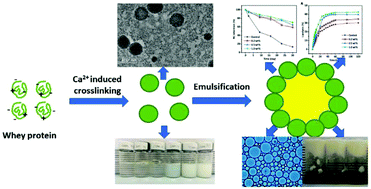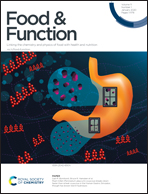Fabrication of high internal phase Pickering emulsions with calcium-crosslinked whey protein nanoparticles for β-carotene stabilization and delivery
Abstract
Whey protein isolate (WPI) nanoparticles were fabricated with Ca2+ induced cross-linking and used as an effective particle stabilizer for high internal phase Pickering emulsion (HIPPE) formulation aiming to improve the chemical stability and bioaccessibility of β-carotene (BC). Ca2+ concentration dominated the characteristics of WPI nanoparticles. Spherically shaped and homogeneously dispersed WPI nanoparticles with a Z-average diameter of approximately 150.0 nm were obtained with 5.0 mM Ca2+ concentration. No cytotoxicity was observed for WPI nanoparticles even at 10.0 mg mL−1 concentration. HIPPE (oil fraction 80.0%, w/w) can be successfully prepared with WPI nanoparticles at a concentration as low as 0.2% (w/w) and was stable for at least 2 months at room temperature. A higher WPI nanoparticle concentration resulted in more solid-like HIPPEs. BC exhibited appreciably higher retention in HIPPEs than in bulk oil during 30 days of storage at 50 °C. Moreover, BC bioaccessibility was appreciably improved with the HIPPE delivery system. Both the chemical stability and bioaccessibility of BC increased with the increase of WPI nanoparticle concentrations from 0.2 to 1.0% (w/w). The results obtained in this study may facilitate the fabrication of edible and biocompatible protein-based nanoparticle stabilizers for HIPPE formulation with more innovative and tailored functionalities.



 Please wait while we load your content...
Please wait while we load your content...